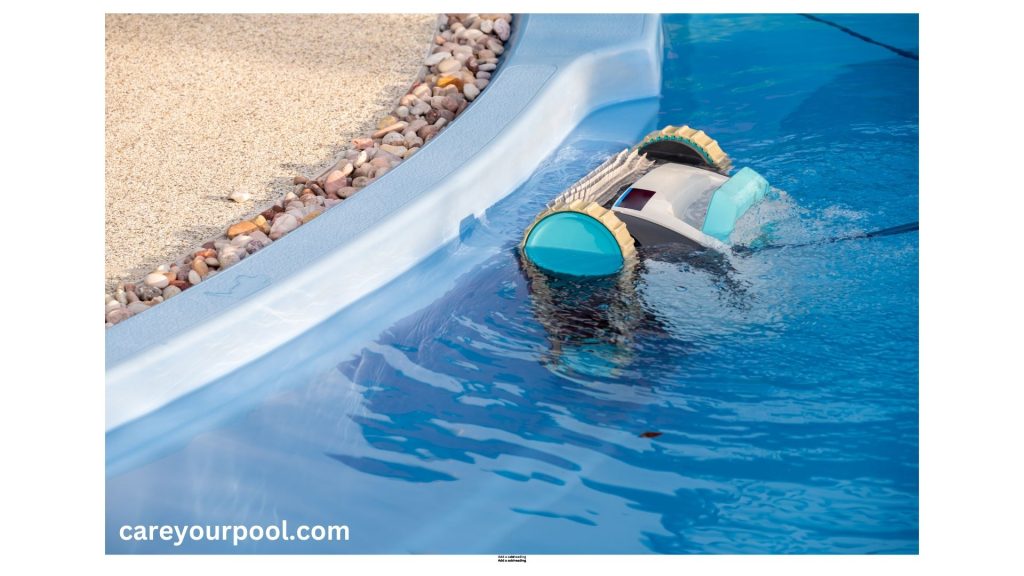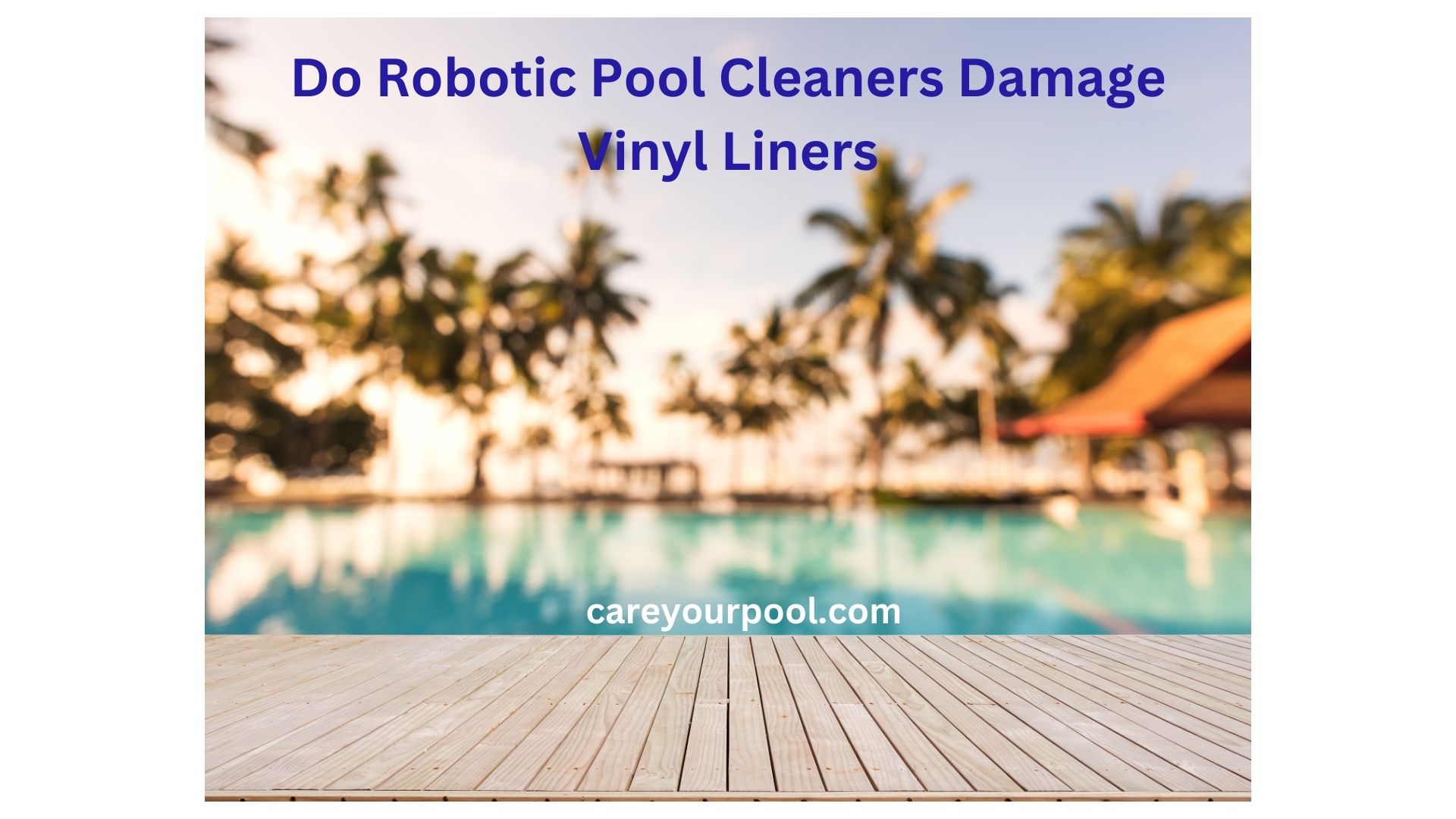Do you own a pool and are thinking about coating it with vinyl? Or perhaps you already have one and are interested in using a robotic pool cleaner to make maintenance easier. Although robotic pool cleaners and vinyl pool liners have many advantages, improper use could result in risks and disadvantages.
Now, the question arises: Do Robotic Pool Cleaners damage Vinyl Liners?
Robotic pool cleaners scrub the pool’s surface with gentle, non-abrasive brushes to protect the lining. They also work with minimal pressure and suction, which lessens the chance of tearing or puncturing the liner.
In light of this, it’s critical to pick a robotic pool cleaner that is created especially for use with vinyl coverings. Some cleansers might have wheels or brushes that are too abrasive for the substance, which over time could harm it.
To avoid any problems, it’s also essential to carefully follow the manufacturer’s directions and take care of the cleaner.
What are Vinyl Liners?
Vinyl liners are a type of swimming pool liner made of a polymer resin, rather than natural fibers or concrete. Compared to other pool cover materials, vinyl is lightweight and easier to clean. There are many advantages and disadvantages of using Vinyl Pool Liners when we pair them with Robotic Pool Cleaners.
Because it is typically more affordable than other types of liners and requires little upkeep, vinyl is frequently used for residential pools. The only drawback is that vinyl liners tend to deteriorate more quickly than other kinds of liners, particularly if they aren’t kept up with.
Vinyl liners are generally clear and made of plastic, though other varieties come in an abundance of hues and patterns. They can be produced using a variety of materials, such as styrofoam, polypropylene, and polyethylene (PE). (PS).
Vinyl Pool Liners vs Regular Pool Liners
Here is a comparison chart showing how Vinyl Liners are different from other types of pool liners:
| Aspect | Vinyl Pool Liners | Regular Pool Liners |
| Material | PVC Vinyl | Various (tile, concrete, fiberglass, etc.) |
| Lifespan | 10-15 years | 5-10 years (depending on material) |
| Durability | Resistant to punctures, tears, and UV damage | Prone to punctures, tears, and UV damage |
| Customization Options | High | Limited |
| Aesthetics | Limited designs and patterns | Various designs and patterns |
| Installation | Easy to install | More complicated and expensive to install |
| Maintenance | Easy to clean | Require more maintenance, repairs, and upkeep |
| Cost | Moderate | More expensive |
According to the comparison table between vinyl pool liners and standard pool liners, vinyl pool liners are a cost-effective alternative that offers a soft, smooth surface, simple installation, and custom designs.
Contrarily, conventional pool liners made of fiberglass or concrete are more expensive and offer fewer customization options, but they are also more durable, long-lasting, and simple to maintain. The decision between the two varieties of pool covers ultimately comes down to taste and price.
What are the advantages and disadvantages of Vinyl Liners?
Since vinyl liners are lightweight, inexpensive, and simple to maintain, they are a common choice for pool cleaning. However, they are not without flaws, especially if you reside in a region with harsh water.
Pros:
- Vinyl inserts are inexpensive and simple to keep clean.
- Because they are lightweight, moving them around is simple when required.
- They won’t harm walls or other surfaces because they are flexible where the connections are.
Cons:
- If used incorrectly, vinyl liners can harm your vinyl lining. (for example: if too much pressure is applied).
- If you choose vinyl liners as your pool cleaning option and live in a hard-water region, they might need more frequent maintenance than other materials.
Robotic Pool Cleaners and Vinyl Pool Liners: How are they complementary?

The Effect of Robotic Pool Cleaners on Vinyl Liners
Robotic pool cleaners are becoming more and more well-liked as they make maintaining a pool much easier and more effective. Robotic pool cleaners undoubtedly have their advantages, but they may also harm the vinyl lining, one of a pool’s most vital parts.
Wear and tear is the main issue with vinyl liners when it comes to robotic pool cleaners. Robotic pool cleaners have the potential to be quite strong, and as they travel around the pool, the friction they create can wear down the vinyl lining. This can cause the vinyl to deteriorate over time, resulting in fading, stains, and even splits.
How do Robotic Pool Cleaners cause damage to Vinyl Liners?
It is crucial to use the robotic pool cleaner’s proper parameters. The vinyl liner could stretch, warp, or even break if it is set too high. Additionally, incorrect choices could make the cleaner work too hard, which would produce too much noise or vibration.
Maintaining a robotic pool scrubber properly is also crucial. The vinyl liner may prematurely deteriorate if the cleaner is not correctly maintained. This means that you must adhere to all upkeep and repair recommendations provided by the manufacturer.
If used too frequently, the robotic pool cleaner may also harm the vinyl lining. If the cleaner is applied too frequently, the vinyl may eventually become brittle and split. This is why it’s crucial to only occasionally and appropriately use Robotic Pool cleaning.
Finally, when cleaning the vinyl liner, it’s essential to stay away from abrasive cleaners. Vinyl liners are especially vulnerable to damage from abrasive cleansers because they can leave scratches and discoloration. Always use delicate cleaning supplies or a soft pressure washer.
In general, using a robotic pool cleaner can be a wonderful way to maintain and clean your pool. To ensure that the cleaner does not harm the vinyl liner, it is crucial to use it appropriately and to keep it maintained. You can make sure that your vinyl lining lasts for many years by taking a little extra care of it.
The Guide on How to Protect Your Vinyl Liners While Using Robotic Pool Cleaners
The Signs of Damage to Vinyl Liners
As a pool owner, you are aware of the importance of maintaining your pool for its longevity. Unfortunately, a robotic pool cleaner has the potential to harm even the best-maintained pool. Even though these devices can be a huge benefit, improper use can cause vinyl liners to be damaged.
Here are some pointers for using a robotic pool cleaner without harming your vinyl lining:
Discoloration of Vinyl Liners
The vinyl liners may indicate harm if it starts to fade or change color. This might happen as a result of using abrasive cleaning equipment, being exposed to sunshine, or the harsh chemicals in pool water.
Cracks or Tears on the Vinyl Liners
If the vinyl liner is pierced or torn, leaks may occur or dirt and other detritus may become wedged behind the liner. This may result in additional harm and jeopardize the pool’s structural stability.
Uneven patches or “ripples” in the vinyl
When the robotic pool cleaner passes over the same spot frequently, the vinyl can bunch up and cause these problems. This could result in a trip danger or snag the liner and tear it.
Unexpected gaps between the pool liner and the walls
Gaps between the liner and the walls may indicate damage or that the liner has shrunk as a result of exposure to harsh chemicals or the weather. This may result in additional harm and leakage.
How can you differentiate whether your Vinyl Liners were damaged by a Robotic Pool Cleaner or not?
The best method to determine whether your pool liner has been harmed by a robotic pool cleaner is to inspect it frequently. Look for any signs of damage, such as tears, discoloration, or frayed seams, as was previously stated. Keep an eye out for any odd bumps or dimples on the lining.
There is no specific method to differentiate whether the cause of damage was your Robotic Pool Cleaner or something else unless you check for the signs of damage right after you use a Robotic Pool Cleaner.
Your Robotic Pool Cleaner won’t damage your Vinyl Liners if you don’t use the cleaner, right? So, check right after you use a Robotic Pool Cleaner for damages.
What should you look for while checking for damages on your Vinyl Liners?
Search for the following when examining your vinyl liner:
- Cracks, tears, or rips
- Discoloration or fading
- Unusual bumps or dimples
- Loose seams or peeling
You can navigate above where we explained what these signs really look like and how can you check them properly.
When you should seek professional help?
The Vinyl Liners should be repaired or replaced as soon as you can if you see any of the harm indicators mentioned above. A qualified pool cleaner can give guidance on how to approach the problem and assist in determining the extent of the damage.
You can ensure that your pool stays secure and unharmed by taking the time to examine the vinyl liner. Additionally, don’t be afraid to ask for assistance from an expert pool cleaner if you ever see any indications of damage.
Robotic Pool Cleaner and Vinyl Liner Myths 101: What are the common misconceptions about Vinyl Liners?
The Myths and Myth-Busting
Myth 1: Vinyl liners are too fragile for robotic pool cleaners
This is one of the most widespread myths about vinyl coverings and robotic pool cleaners. The fact is that contemporary robotic pool cleaners are made to be kind to vinyl coverings. They can move around the liner without harm thanks to their flexible, rubber wheels and movable scrubber heads. To preserve the integrity of the liner, they are also designed to avoid obstacles like its seams.
Myth 2: Powerful Robotic Pool Cleaners can damage Vinyl Liners
Despite their strength, robotic pool cleaners are not too strong for vinyl liners. The fact is that they have a power level that can be adjusted, allowing you to find the ideal setting for your pool. This makes sure that your vinyl liner won’t be damaged by your robotic pool cleaner’s excessive strength.
Myth 3: Robotic Pool Cleaners are unable to reach the bottom of the pool
Robotic pool cleaners are made to clear the walls, stairs, and bottom of your vinyl liner. They can access the lowest parts of your pool because they are fitted with strong suction and scrubbing brushes.
Myth 4: Using robotic pool cleansers is challenging
The use of robotic pool cleaners is truly very simple. Just turn on the cleaner, set the schedule, and let it take care of the rest. The majority of contemporary versions come with remote control, making it simple to change the settings using your phone or tablet.
Concluding…
In conclusion, vinyl pool liners are a lovely, long-lasting, and affordable choice for pool owners. They come in a variety of colors and patterns and are simple to keep. They offer greater flexibility than other kinds of pool coverings and are damage-resistant.
It’s critical to be conscious of the risks to vinyl liners when using robotic pool cleaners and to take precautions to avoid harm. It’s crucial to recognize the warning indications of damage to vinyl liners and to dispel common misconceptions about robotic pool cleaners and vinyl liners.
It is best to contact a professional to have the liner and cleaner inspected if there is any damage present.
Read more, Learn more
- How long to run polaris pool cleaner?
- How to keep pool hose from coming off?
- How to get air out of pool vacuum hose?
